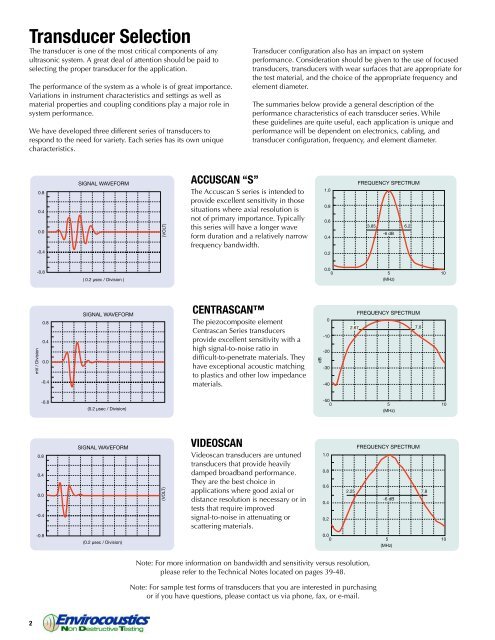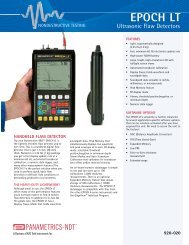Ultrasonic Transducers - Envirocoustics
Ultrasonic Transducers - Envirocoustics
Ultrasonic Transducers - Envirocoustics
You also want an ePaper? Increase the reach of your titles
YUMPU automatically turns print PDFs into web optimized ePapers that Google loves.
Transducer Selection<br />
The transducer is one of the most critical components of any<br />
ultrasonic system. A great deal of attention should be paid to<br />
selecting the proper transducer for the application.<br />
The performance of the system as a whole is of great importance.<br />
Variations in instrument characteristics and settings as well as<br />
material properties and coupling conditions play a major role in<br />
system performance.<br />
We have developed three different series of transducers to<br />
respond to the need for variety. Each series has its own unique<br />
characteristics.<br />
mV / Division<br />
0.8<br />
0.4<br />
0.0<br />
-0.4<br />
-0.8<br />
0.8<br />
0.4<br />
0.0<br />
-0.4<br />
-0.8<br />
0.8<br />
0.4<br />
0.0<br />
-0.4<br />
-0.8<br />
SIGNAL WAVEFORM<br />
( 0.2 µsec / Division )<br />
SIGNAL WAVEFORM<br />
(0.2 µsec / Division)<br />
SIGNAL WAVEFORM<br />
(0.2 µsec / Division)<br />
2 www.olympusNDT.com<br />
(VOLT)<br />
(VOLT)<br />
ACCUSCAN “S”<br />
The Accuscan S series is intended to<br />
provide excellent sensitivity in those<br />
situations where axial resolution is<br />
not of primary importance. Typically<br />
this series will have a longer wave<br />
form duration and a relatively narrow<br />
frequency bandwidth.<br />
CENTRASCAN<br />
The piezocomposite element<br />
Centrascan Series transducers<br />
provide excellent sensitivity with a<br />
high signal-to-noise ratio in<br />
difficult-to-penetrate materials. They<br />
have exceptional acoustic matching<br />
to plastics and other low impedance<br />
materials.<br />
VIDEOSCAN<br />
Videoscan transducers are untuned<br />
transducers that provide heavily<br />
damped broadband performance.<br />
They are the best choice in<br />
applications where good axial or<br />
distance resolution is necessary or in<br />
tests that require improved<br />
signal-to-noise in attenuating or<br />
scattering materials.<br />
Transducer configuration also has an impact on system<br />
performance. Consideration should be given to the use of focused<br />
transducers, transducers with wear surfaces that are appropriate for<br />
the test material, and the choice of the appropriate frequency and<br />
element diameter.<br />
The summaries below provide a general description of the<br />
performance characteristics of each transducer series. While<br />
these guidelines are quite useful, each application is unique and<br />
performance will be dependent on electronics, cabling, and<br />
transducer configuration, frequency, and element diameter.<br />
Note: For more information on bandwidth and sensitivity versus resolution,<br />
please refer to the Technical Notes located on pages 39-48.<br />
Note: For sample test forms of transducers that you are interested in purchasing<br />
or if you have questions, please contact us via phone, fax, or e-mail.<br />
1.0<br />
0.8<br />
0.6<br />
0.4<br />
0.2<br />
1.0<br />
0.8<br />
0.6<br />
0.4<br />
0.2<br />
2.25<br />
FREQUENCY SPECTRUM<br />
3.85<br />
-6 dB<br />
0.0<br />
0 5<br />
(MHz)<br />
10<br />
0<br />
-10<br />
dB -20<br />
-30<br />
-40<br />
2.67<br />
FREQUENCY SPECTRUM<br />
-6 dB<br />
0.0<br />
0 5<br />
(MHz)<br />
10<br />
6.2<br />
FREQUENCY SPECTRUM<br />
-50<br />
0 5<br />
(MHz)<br />
10<br />
7.0<br />
7.8



